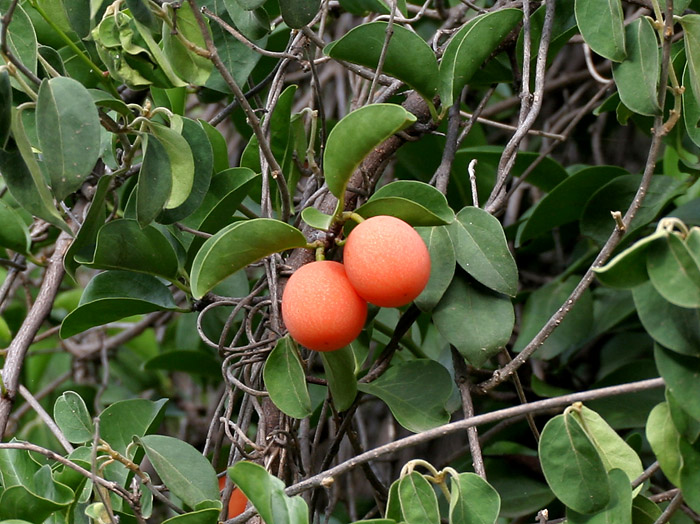Ximenia americana

|
|
Ximenia americana Common Names: Wild Plum, Yellow Plum, Wild Lime,
Seaside Plum, Hog Plum, Tallow Wood Scientific
Classification Kingdom: Plantae Clade: Tracheophytes Clade: Angiosperms Clade: Eudicots Clade: Rosids Order: Santalales Family: Olacaceae Genus: Ximenia Species: X. americana Binomial Name: Ximenia americana L. Synonyms: Ximenia elliptica Forst.f., Ximenia aegyptiaca L. Morphological Description Ximenia americana, commonly known as Wild Plum or Yellow Plum, is a small tree or
shrub growing 2–7 m tall, with a trunk diameter up to 10 cm. It is
characterized by: · Bark: Dark brown to pale gray, rough, often peeling in thin strips · Branches: Spiny, zigzag, with short, stiff thorns up to 2 cm long · Leaves: Alternate, elliptic to ovate, 3–6 cm long, 1–3 cm wide,
leathery, glossy green · Flowers: Small, fragrant, white to greenish-yellow, 5–8 mm long, in
clusters, blooming year-round in tropics · Fruit: Drupe, 2–3 cm in diameter, green turning yellow to orange
when ripe, with a tart-sweet flavor Its semi-parasitic roots
attach to nearby plants, aiding nutrient uptake. Distribution and Habitat Ximenia americana is pantropical, found across Africa (e.g., Nigeria, Kenya,
South Africa), the Americas (e.g., Brazil, Florida), Asia (e.g., India,
Thailand), and Australia. It thrives in: · Habitats: Savannas, woodlands, dry forests, coastal dunes, scrublands · Climate: Tropical and subtropical, with rainfall of 500–1,500 mm
annually, temperatures of 20–38°C · Soil Conditions: Well-drained sandy or loamy soils (pH
5.5–7.5), often in arid zones · Elevation: Sea level to 2,000 m Its resilience makes it
a pioneer species in disturbed areas. Ethnopharmacology Ximenia americana, commonly known as wild plum or yellow plum, is a medicinal plant
extensively used in traditional medicine across Africa, Asia, and tropical America.
Various parts of the plant, especially the leaves, roots, bark, seeds, and
fruits are employed for their wide range of therapeutic properties. It is
traditionally used to treat skin infections, wounds, diarrhea, fevers, malaria,
muscle pain, and respiratory ailments. The plant exhibits antimicrobial,
anti-inflammatory, analgesic, antioxidant, antimalarial, and astringent
effects. The root and bark are commonly used as topical applications for skin
conditions and ulcers, while the leaves and fruits are often taken as
decoctions to address internal infections and digestive issues. Phytochemical
analyses have identified active constituents such as flavonoids, saponins,
tannins, alkaloids, and fatty acids, which contribute to its medicinal value.
Despite its broad traditional use, more scientific and clinical studies are
needed to validate its pharmacological effects and ensure safe dosage
guidelines. · Antimicrobial: Leaf extracts inhibit *Escherichia coli* and *Candida
albicans*, used in Mali for infections. · Antioxidant: Fruit polyphenols neutralize free radicals, used in Tanzania
for oxidative stress. · Gastrointestinal Treatment: Root decoctions treat diarrhea in Nigeria,
with tannins aiding gut health. · Skin Conditions: Seed oil heals ulcers in South Africa, with
fatty acids promoting regeneration. · Antimalarial and Antipyretic: Bark extracts lower fever in Ethiopia,
showing activity against *Plasmodium* species. ⚠ Toxicity Profile: No acute toxicity at traditional doses, but seeds contain
cyanogenic glycosides (e.g., hydrocyanic acid), potentially releasing cyanide
if ingested raw in excess. Fruits are safe in moderation but may cause nausea
if overconsumed. Use under guidance is advised. Phytochemistry The plant’s medicinal
properties stem from a rich phytochemical profile: · Fatty Acids: Linolenic, linoleic, oleic, and stearic acids in seeds, with
antimicrobial and emollient effects · Flavonoids: Quercetin and kaempferol, providing antioxidant benefits · Tannins: Astringent compounds aiding wound healing · Terpenoids: Anti-inflammatory and analgesic agents · Phenolics: Gallic acid, supporting antimalarial properties · Alkaloids: Contribute to antimicrobial actions The fruit is notably
high in vitamin C, enhancing its nutritional value. Additional Uses · Nutritional: Fruits eaten raw, dried, or as juice in Senegal, rich in
vitamin C and potassium · Cosmetic: Seed oil used in Brazil for hair conditioning and skin
moisturizing · Economic: Wood crafted into tools and fuel in Kenya · Ethnoveterinary: Leaves treat livestock wounds in Namibia References
External Links More Pictures |
|
| Compounds of Ximenia americana | |
| References |